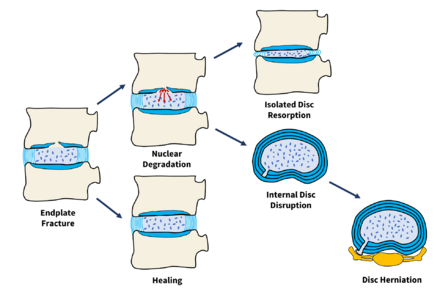⬤
◕
Bogduk's Postulates
From WikiMSK

Internal disc disruption (third column second row) as a cause for chronic low back pain fulfils postulates 1, 3, and 4 and has survived copious scientific scrutiny.[1]
Bogduk's postulates are the considerations or conditions concerning whether any structure can be deemed to be a credible cause of pain, i.e. a pain generator. They are analogous to Koch's postulates for bacterial diseases. The postulates are typically applied to the spine.[2]
- Innervated: The structure should have a nerve supply.
- Experimental pain in normal volunteers: The structure should be capable of causing pain, similar to that seen clinically, ideally in normal volunteers, e.g. with noxious injection
- Pathology known: The structure should be susceptible to diseases or injuries that are known to be painful. Certain conditions however are not detectable using currently available imaging techniques, and in these cases the next line of evidence is used which is evidence from post-mortem studies or biomechanical studies, e.g. with facet joint pain.
- Identified in patients: The structure should be a source of pain in patients, using validated diagnostic techniques such as positive controlled nerve blocks to the sensory supply of a joint. Due to false-positive responses, diagnostic blocks must be controlled. Prevalence data can be determined here.
See Also
References
- ↑ Bogduk, Nikolai; Aprill, Charles; Derby, Richard (2013-06). "Lumbar Discogenic Pain: State-of-the-Art Review: Lumbar Discogenic Pain". Pain Medicine (in English). 14 (6): 813–836. doi:10.1111/pme.12082. Check date values in:
|date=(help) - ↑ Bogduk. Low back pain In: Clinical and Radiological Anatomy of the Lumbar Spine. 5th Edition. Elsevier 2012
Literature Review
- Reviews from the last 7 years: review articles, free review articles, systematic reviews, meta-analyses, NCBI Bookshelf
- Articles from all years: PubMed search, Google Scholar search.
- TRIP Database: clinical publications about evidence-based medicine.
- Other Wikis: Radiopaedia, Wikipedia Search, Wikipedia I Feel Lucky, Orthobullets,


